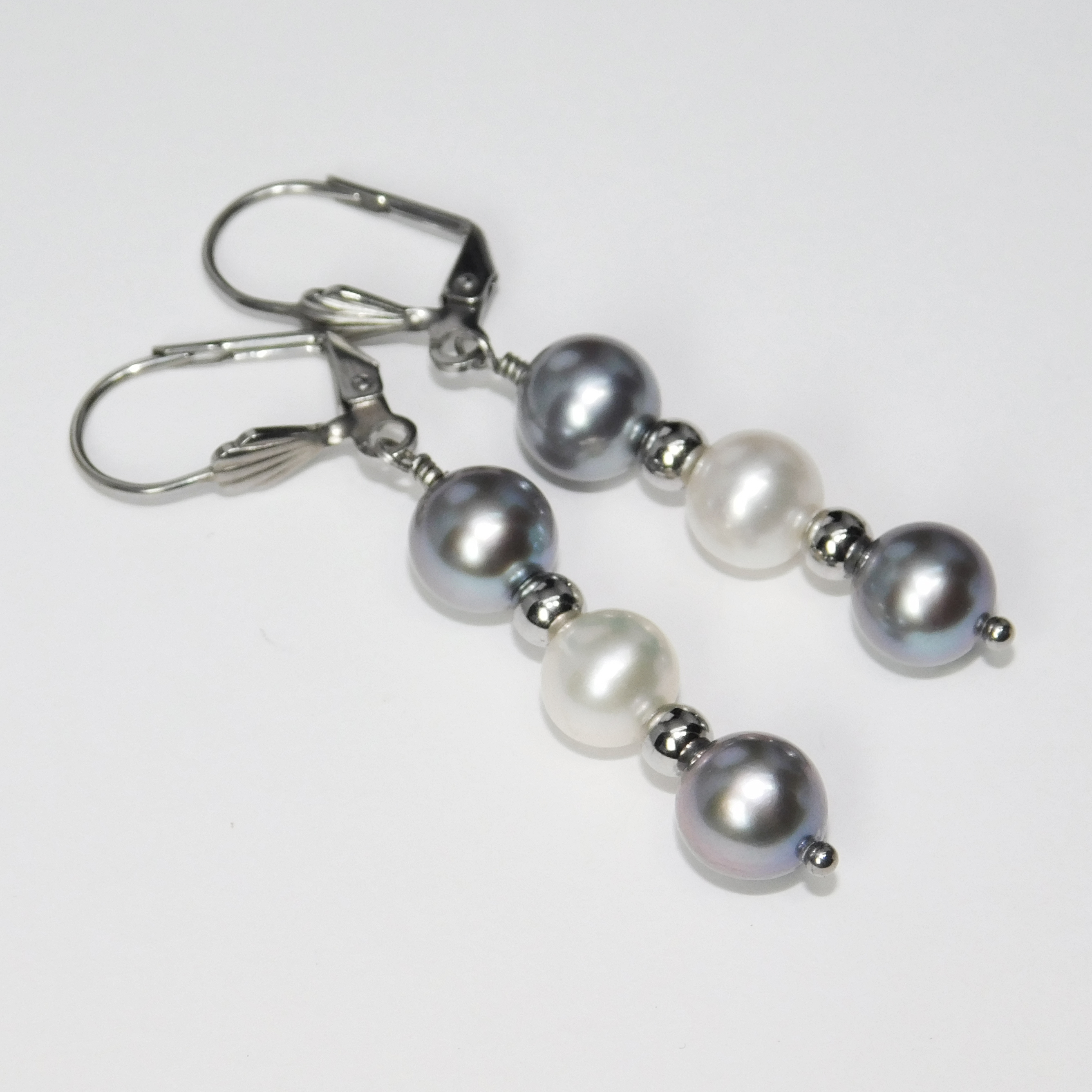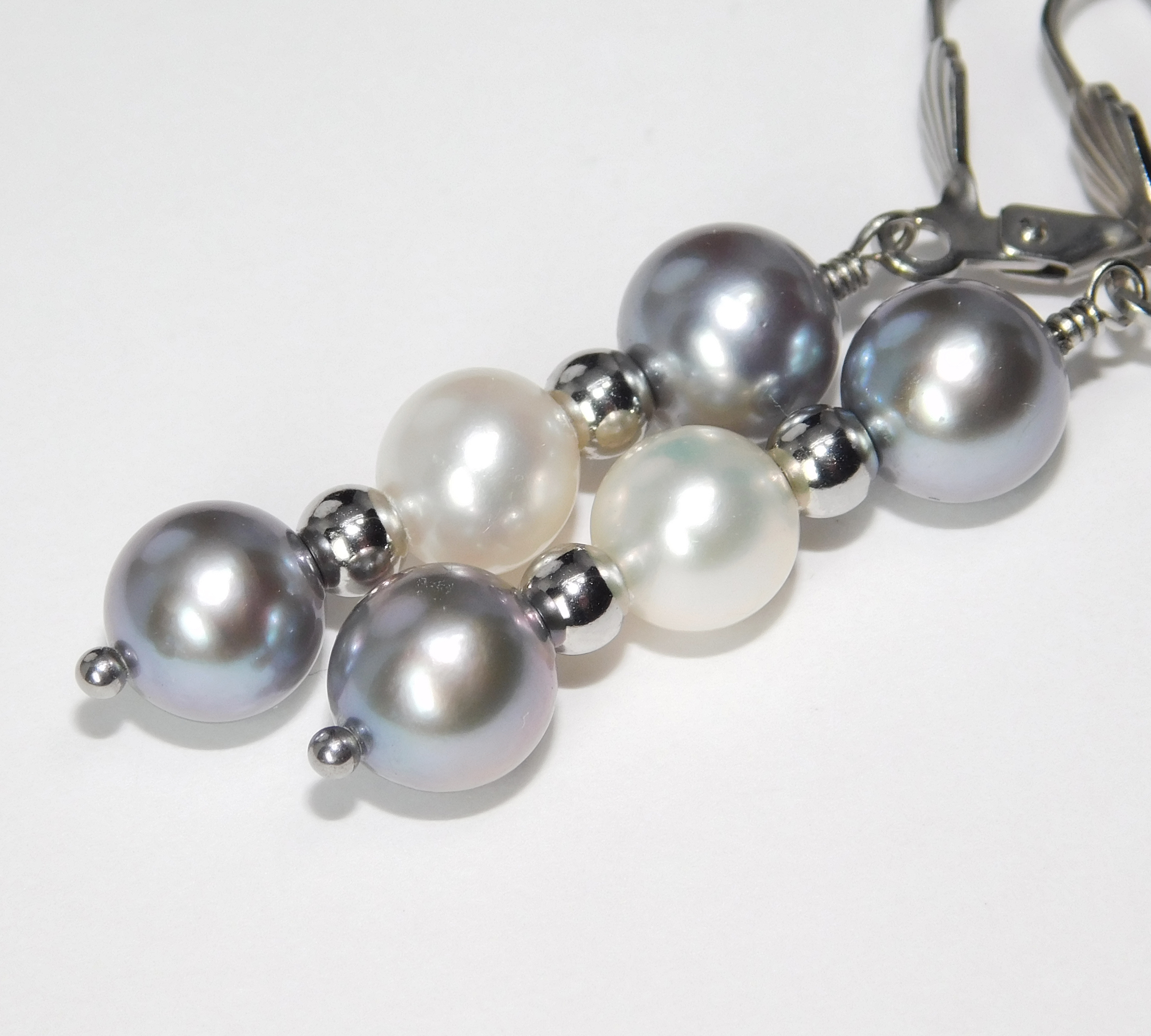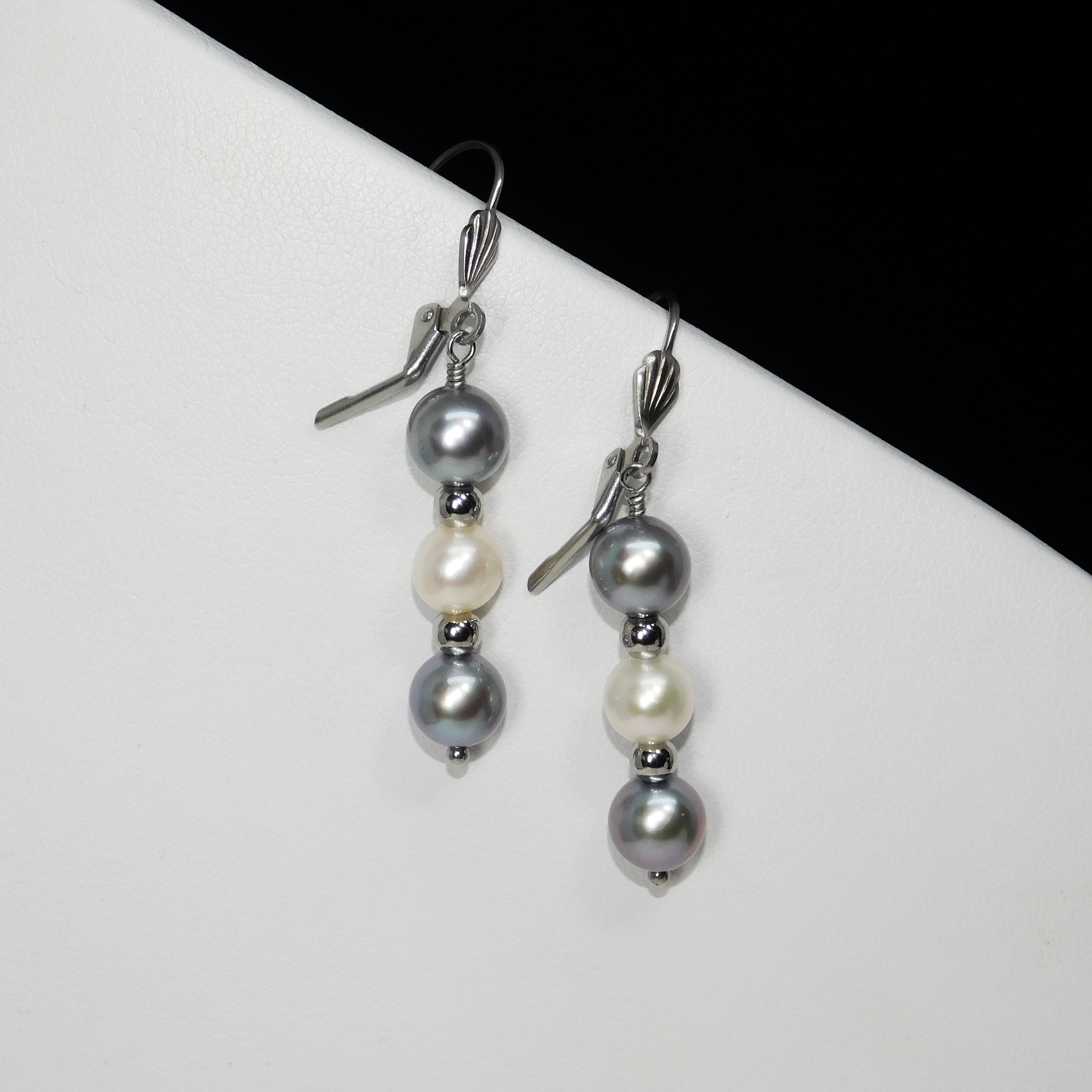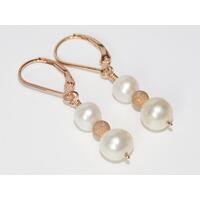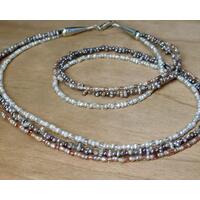About this Product
The classic pair of earrings. They will go with any outfit, to work or out to dinner.
They are heirloom quality and will be passed through the generations in your family.
Natural pearls are found in the Crown Jewels of many nations throughout the world.
The white pearls are rare, natural, uncultured from the Arabian Gulf near Bahrain. Currently the Basra pearl harvest is small and astronomically expensive. I use vintage pearls around 30 years old with good luster and shape. The grey blue pearls are Japanese saltwater Akoya. The color is achieved by irradiating the white Akoya pearls. That changes the color permanently. They are not dyed. The pearls measure 7.5 to 8 mm, and the earrings are 2" in total length. I have used sterling and stainless accent beads, wire, and lever backs.
US dime (18 mm) included for scale. Pearl info below.
Pearls are one of the most beloved gems, used for millennia in jewelry and decoration, and are the only gems grown inside a living organism. The first recorded mention of pearls is 7,500 years old. They are one of a few organic gemstones, including ivory, amber, and coral.
Pearls are one of the birthstones of June, along with color-changing alexandrite, and moonstone. It is also the 3rd and 30th wedding anniversary gem.
Basra pearls are rare, natural, uncultured pearls from the Arabian Gulf, prized for millennia as the standard of natural pearls. While the term encompasses natural pearls from the Arabian Gulf, "Basra" refers to the city which was a trading hub for the pearls in the past. They are grown by the Pinctada radiata oyster, yet overfishing and pollution due to the region's oil production has only increased their rarity. While a small amount is still harvested, the majority of Arabian Gulf pearls on the market are vintage.
The combination of fresh and saltwater, warm and shallow waters, and nutrient levels of the Arabian Gulf directly affects the colors and iridescent luster of Basra pearls. The crystalline layers of nacre scatters light creating a silky luster in white, cream, silver, pink, and golden colors. Most are baroque in shape, making round Basra pearls more rare in comparison. They are also lighter in weight than other natural pearl counterparts.
The nation of Bahrain, known as The Island of Pearls, thrived as a pearling center for over 4,000 years, and it was even mentioned in the writings of Pliny the Elder, considered by some to be the first gemologist. Pearl divers in the Gulf used to go out on boats for months at a time, diving for pearls while holding their breath, while their families would sing and pray for their safe return in the dangerous industry. 70-80% of all pearls originated from the gulf area until the 1950s, and represented up to 95% of local incomes and 75% of the Gulf's total exports during the peak. The Bahrain pearl beds were designated a World Heritage Site in 2012.
The invention of cultured pearls, world wars, and oil discovery crashed the natural pearl market in the mid-20th century, yet the prestige of natural pearls remains uncontested. Natural pearls make up only 2-5% of pearls available on the market today, and Basra pearls only claim a fraction of that amount. Only about one in 10,000 wild oysters will yield a natural pearl, and not all of those pearls are gem quality.
Basra pearls have been a feature in crown jewels and jewelry of the ultra-wealthy for many centuries, adorning royalty, clothing, palaces, thrones, screens, pillars, doorways, and even a carpet called the Baroda Pearl Canopy. Notable examples of Basra pearls include the jewelry of Empress Eugenie, Queens Elizabeth I and II, Nizams and Maharajas of India, and countless others. The Maharaja of Baroda, Khande Rao Gaekwar, commissioned an incredible seven-strand necklace worn for generations, of which only two strands survived to be sold by Christie's in 2007 for $7.1 million USD.
The akoya pearl is a saltwater cultured pearl from the akoya oyster (Pinctada fucata martensii) which thrives in the cold saltwater of the Pacific Ocean amid the secluded bays off the coast of Japan. It was the first pearl to be cultivated in the late 19th century and successfully marketed by Mikimoto, a name which is now synonymous with the Akoya pearl, though Mikimoto wasn't the first and only person experimenting with pearl cultivation. Cultured pearls revolutionized the world of fine jewelry, making pearls more readily available to buyers of all types and budgets. Before cultured pearls, only natural pearls had been available, so the supply was severely limited and often reserved for royalty. By the 1920s, Mikimoto's cultured pearl business was a commercial success. The akoya oyster is the smallest commercially farmed, pearl-producing oyster, averaging 3-5 inches in diameter, so the pearls produced tend to be on the smaller side. Akoya are considered to be the classic pearl used for necklaces and other pearl jewelry, with perfect round shapes, bright mirror-like luster and neutral colors.
Pearl nacre is made of layers of mineral platelets, stacked like bricks and held together with proteins, which reflect and refract light to create iridescence, depth, and color. Each crystalline platelet acts like a miniature prism, breaking up the beam of white light into a rainbow. Pearl irradiation uses Cobalt-60 to permanently turn a pearl nucleus black post-harvest, which changes the color the pearl refracts, giving an irradiated pearl a darker, silvery, or bluish color. Dye is not a part of the process, as you can still see the iridescence in the nacre, which pearl dyeing removes. Dye creates a pearl without iridescence and depth, giving a pearl a flat, solid surface layer.
JReneau - Pearl Girl

Meet the Maker
I am the mother of three daughters. I also have four grandchildren, 2 boys and 2 girls. We all live here & see each other nearly everyday. I am very blessed.
I have been an artist all my life. I have painted in watercolor for over 40 yrs. I have been a paper maker for 16 yrs. Look in my shop sections for Fine Art and Handmade Paper. I have been a jewelry artist for 12 yrs.
I take my work seriously. I use the best materials and am proud of my creations. I’m in love with color change gemstones and feature them as often as I can. I also love American Gemstones and do some rock hounding myself.
If you are looking for a particular gem or mineral, contact me. I have lots of goodies not show in my shop yet. Blessings, Jane
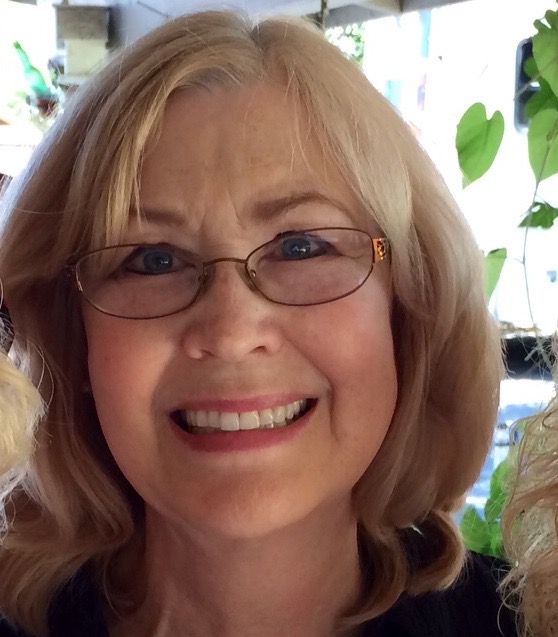
How it’s Made
Basra and akoya pearls on stainless steel wire with sterling silver accent beads, all on stainless steel lever backs.
Shop Policies
Returned items must be in the original condition for refund. We urge you to insure the package as we are not responsible for loss or damage. Please notify us of your intent to return the item prior to shipping.
We accept returns and cancellations
- Contact me within: 3 days of delivery
- Ship items back within: 7 days of delivery
- Request a cancellation: as soon as possible, before the order has shipped.
- Buyers are responsible for return shipping costs and insurance. If the item is not returned in its original condition, the buyer is responsible for any loss in value.
